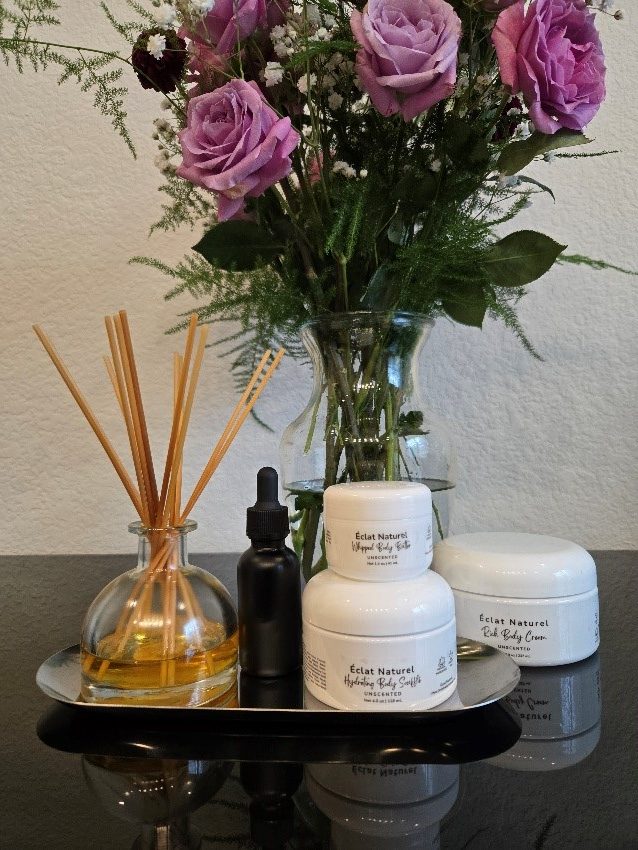Blog
How Your Skin Changes with the Seasons (And Why You Should Pay Attention)

Presented by Eclat Naturel
We tend to think of our skin as a constant, something that stays the same unless something drastic happens. But the truth is, your skin is incredibly responsive. It reacts to your environment, your stress, your sleep… and yes, to the seasons.
Have you ever wondered why your skin feels dry and tight in winter but oily or more prone to breakouts in the summer? You’re not imagining things. Seasonal skin changes are real, and they affect everyone, no matter your age, skin type, or climate.
Let’s break down what happens to your skin as the weather shifts throughout the year.
Spring: The Wake-Up Season
After months of dry, cold air, your skin starts to wake up in spring. As temperatures rise and humidity increases, your skin may begin producing more oil, which can sometimes trigger breakouts, especially if dead skin cells have built up over winter.
What’s common in spring?
- Mild congestion or clogged pores
- Fluctuating oil levels
- Sensitivity to pollen or new environmental allergens
- A “dull” appearance as skin adjusts
This is the time your skin starts renewing itself more quickly, but it might also feel unpredictable. It’s adjusting to moisture in the air, warmer temps, and outdoor exposure. A good spring focus is on gentle renewal and allowing your skin to rebalance.
Summer: Oil, Sweat, and Sun
Summer can be a love-hate season for your skin. On one hand, there’s more natural glow and warmth in your complexion. On the other hand, there’s sweat, humidity, clogged pores, and an increased risk of UV damage.
What’s common in summer?
- Increased oil production
- Sweat-related breakouts, especially around the hairline and back
- Dehydration from the sun and heat
- Uneven tone from sun exposure
Even though summer brings oil, your skin can still be dehydrated, meaning it lacks water, not oil. It’s a tricky balance. This is the season when your skin needs protection, hydration, and frequent cleansing to keep up with the environmental demands.
Fall: The Transition Phase
Fall is the season of change, not just for trees, but for your skin, too. As temperatures drop and the air becomes drier, your skin often reacts with tightness and irritation. It may start to feel more sensitive or reactive, especially after the summer’s sun and sweat.
What’s common in fall?
- Flakiness and dryness around the nose, mouth, or forehead
- Sensitivity or redness
- Uneven texture as skin adjusts to drier air
- A return of eczema or seasonal irritation
This is the time when your skin begins needing more moisture and gentler care. It’s also a great season to reset your routine and focus on healing any summer damage.
Winter: Dry, Tight, and Demanding
Winter is often the most challenging season for skin. Cold outdoor air combined with dry indoor heat creates the perfect storm for skin issues. The protective barrier of your skin weakens, leading to that familiar tight, itchy, or ashy feeling.
What’s common in winter?
- Persistent dryness and flaking
- Chapped lips and rough patches
- Increased sensitivity
- Slower skin cell turnover
This season calls for extra nourishment and care. It’s not uncommon for people who don’t normally have dry skin to suddenly experience tightness or dullness in winter. Your skin is working overtime to stay hydrated, and often needs more help than usual.
The Bottom Line
Your skin is constantly evolving, and the seasons are one of its biggest influencers. By tuning in to how your skin feels during each part of the year, you’ll start to notice patterns: maybe you break out in May, or your cheeks always get red in November. These changes aren’t random; they’re your skin asking for a different kind of support.
Understanding your skin seasonally doesn’t mean overhauling your routine four times a year. It just means paying attention, being flexible, and making small adjustments based on what your skin is trying to tell you.
Your skin isn’t difficult, it’s dynamic. Let it change with the seasons. All you have to do is notice, respond, and care.

